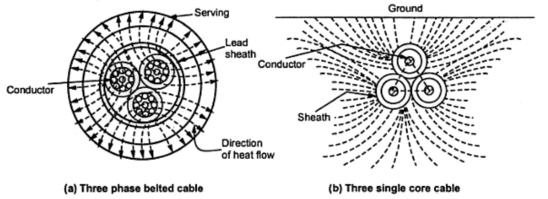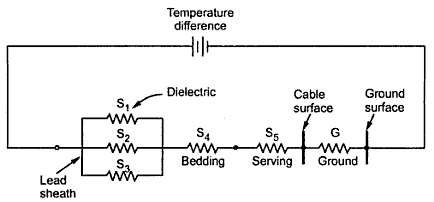The path for the heat dissipation is through the dielectric, then
sheath, bedding, serving and finally into the surrounding soil or air.
The heat flow in a 3 phase belted cable is shown in the Fig. 1(a) while
heat flow due to a three single core cable to ground is shown in the
Fig. 1(b).
 |
| Fig. 1 |
In case of three phase belted cable, the heat flows through three
parallel paths and all the three conductors are at same temperature.
The overall heat flow in a cable is similar to the flow of leakage
current in an electric circuit ; flowing radially out from core to
ground through dielectric, sheath, bedding armouring and serving.
1.1 Thermal Characteristics of Cable
The current in an electric circuit is given by,
Similarly heat flow H is given by,
Similarly heat flow H is given by,
Thermal resistance S is defined as the resistance which allows the heat
flow of 1 watt when a temperature difference of is maintained. It is
given by,
Where k = Thermal resistivity of the material
l = Length of the path of heat flow
A = Area of section through which heat flows
The thermal resistivity is expressed in oC/watt/cm
Consider the equivalent circuit for heat flow in a three phase cable as shown in the Fig. 2.
 |
| Fig. 2 |
The total temperature difference is difference between conductor temperature and ambient temperature. The S1, S2 and S3 are
thermal resistances of the three dielectric paths which are in
parallel. Then heat flows through bedding whose thermal resistance is S4. Finally it flows through serving whose thermal resistance is S5.
The G represents the thermal resistance of ground to ambient
temperature. The current carrying capacity of cables depends on the heat
dissipation and to calculate it, it is necessary to obtain the thermal
resistances of various parts through which heat flows.
Consider a single core cable as shown in the Fig. 3. let
r = Core radius
R = Overall radius
l = Length
k = Thermal resistivity
The value of k for the cables above 22 kV is 550 while it is 750 for pressure upto and including 22 kV.
It is difficult to find the expression for the thermal resistance of
three core cable. The empirical formula given by Simon is,
Where T = Thickness of the conductor insulation
t = Thickness of the belt insulation
r = Radius of the condcutor
1.3 Thermal Resistance of Soil
The thermal resistance of the soil depends on the nature of the soil
and its moisture content. Hence exactly thermal resistance can not be
obtained for the soil. Assuming the ground to be isothermal and
homogeneous, the thermal resistance of ground is given by,
Where k = Thermal resistivity of soil
h = Depth of cable axis below the soil
R = Radius upto lead sheath i.e. overall radius
In practice it is necessary to multiply value of k by 2/3 which is
obtained in the laboratory, to obtain acula value of G.












No comments:
Post a Comment